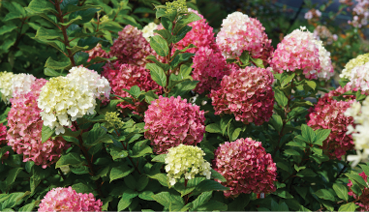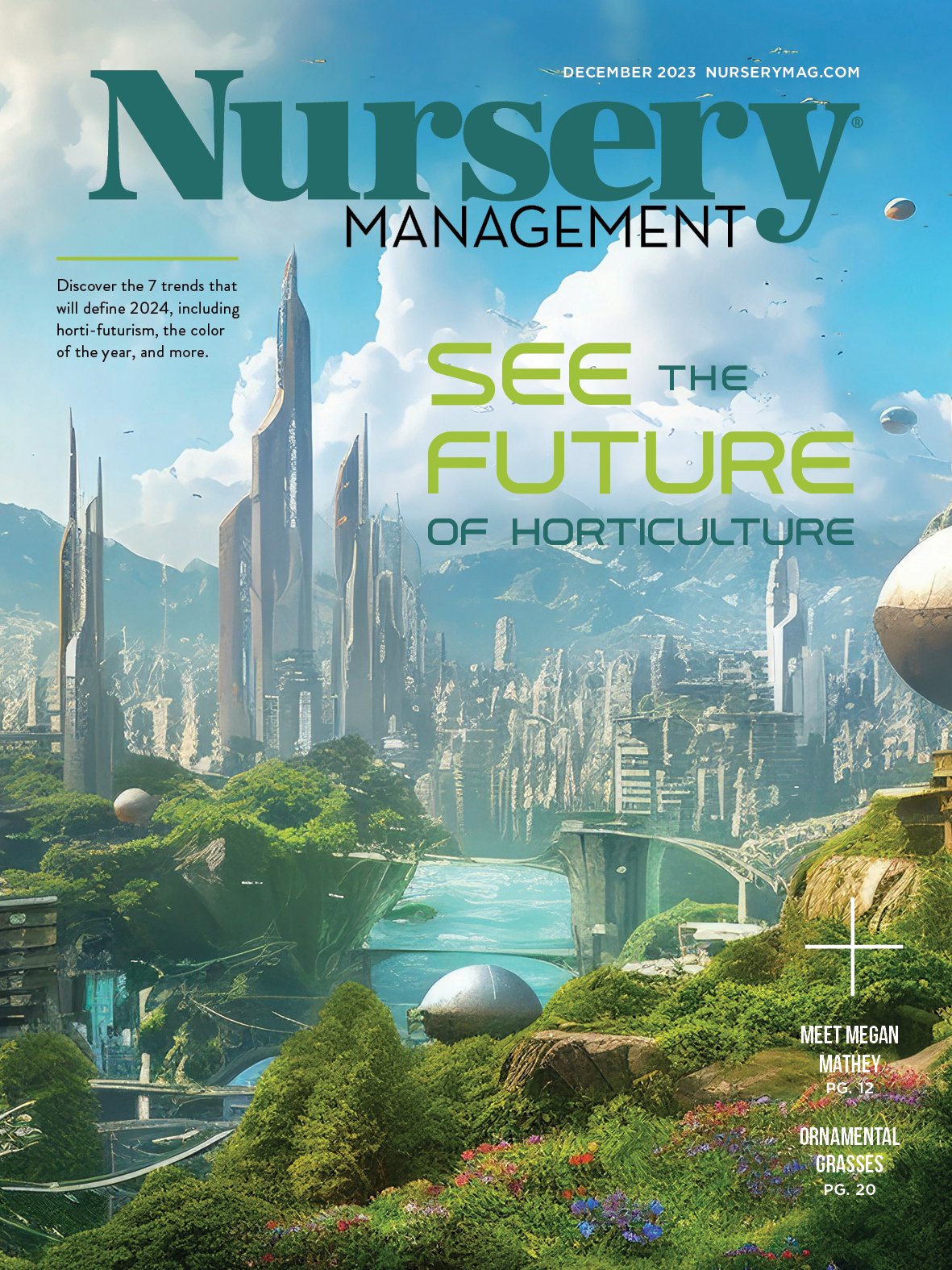
Wee Bit Innocent.
Megan Mathey spends her days walking through 30 acres of research field at Spring Meadow Nursery. She enjoys coming across things she’s never seen before such as discovering a new trait breakthrough or finding an improvement she gets excited about. Her favorite part of plant breeding is the thrill of discovery.
“It’s a little bit like Christmas,” Mathey says. “You can just go wandering [through] our fields and our seedlings, and you’re always going to find something new.”
Mathey is the ornamental plant breeder at Spring Meadow Nursery, and she has a master’s degree in plant breeding and genetics from Oregon State University. She started as a plant breeder at Spring Meadow Nursery in 2013.
Mathey is from Rapid City, South Dakota, and both of her parents were avid gardeners when she was growing up. Her family always had a large vegetable garden, and her mother enjoyed planting flowers around the house.
“I was always fascinated with plants,” Mathey says. “That’s what we spent our weekends doing. It was either gardening or camping.”

Mathey’s favorite plant that she’s developed.
Mathey’s first job was unpacking flowers at a local florist shop when she was 12 years old. Later, she started working at a local nursery, The Plantsmyth, where she transplanted seedlings, weeded, helped customers and did other general nursery tasks.
“When I was working at the nursery, we would get a lot of trade magazines,” Mathey says. “We would be in the break room [reading] about the people behind the development of the plants. It got me questioning – who are those people? How did they get into that kind of industry? It was fascinating to me because we would get new product every single year, and I was always curious about how these plants came about.”
The thought of someone coming up with new ideas and breeding new plants intrigued Mathey. She loved working with plants, so she decided to make a career out of it. Mathey attended the University of Minnesota for her undergraduate degree, and she majored in horticulture with an emphasis in science.
Look for something different
Mathey had the opportunity to work on an undergraduate research project alongside one of the professors, Neil Anderson. The intergeneric hybrid project consisted of ornamental, container and annual type plants – gaura, oenothera and epilobium. They were trying to cross them with each other to create sterile plants. Mathey also assisted with breeding chrysanthemums.
“That was my first introduction to plant breeding,” Mathey says. “I loved working for him, but most of his products were greenhouse grown, like your annuals and perennials. I was more drawn to being outside. I liked working with woody plants, so the only kind of equivalent program was an apple breeding program.”
Mathey worked through the apple breeding program during her remaining years at the University of Minnesota. She worked with David Bedford, one of the breeders who originally released the Honeycrisp apple.

for controlled pollination.
“He was a new breeder, taking over for his predecessor,” Mathey says. “He was [tasting] all the fruit; trying to learn which fruit was good and how to do the selecting process. He came to the original Honeycrisp tree, and it was flagged for removal, meaning the previous breeder had marked it saying this tree is not good enough; it’s not going to move forward. He ended up removing [the flag] because it was the best tasting fruit he had ever had on an apple tree. … The biggest lesson I learned from that is that the selecting process is really important, and not to be afraid to look beyond what might be seen at face value for something different.”

New or improved
When Mathey started at Spring Meadow Nursery, she had one Quonset house that was filled with her mother plants and five other Quonset houses for trials. Her role was to collect pollen, make pollinations, collect the seed and sew the seed out. She would then begin making selections.
“In my mind, that’s what plant breeding is,” Mathey says. “That beginning process and everything it takes – idea generation, collecting the pollen, making hand physical pollinations, collecting that seed, sewing it out, all the way up to the point where you’re going out to your populations and making selections.”
During this time, Spring Meadow Nursery had a small tissue culture lab that Mathey used for research purposes, and she was in charge of collecting the patent data and releasing new plants.
In 2022, the nursery was able to hire another full-time breeder, so Mathey’s role transitioned to being manager of the program. Spring Meadow Nursery now has a 10-acre research facility, and her role has shifted from the beginning stages to the end stages of plant breeding.
Now, Mathey is primarily involved in trialing plants. After the selections are made and varieties are in the trials, she decides which varieties move forward and which ones may be eliminated from the trial. The varieties that may not have all the attributes she was looking for, but have a few, will become germplasm for parent material.
“I think there is a lot of untapped genetic diversity in each crop that we work with,” Mathey says.
Some of the characteristics Mathey looks for when selecting a plant are improved disease resistance, improved hardiness, larger flower size, more flowers, longer bloom period and dwarf plants.
Mathey loves the excitement of finding something new, and she enjoys setting specific selection criteria for crops and the challenge of finding plants that meets those criteria. For example, when breeding Hydrangea macrophylla, she looks for the ability to overwinter and flower reliably in Zone 5 climate types, as well as the ability to be a reblooming plant.
Mathey has developed 33 plants since she started working at Spring Meadow Nursery, and H. paniculata Little Lime Punch is currently her favorite.
“It’s a much more compact form of Hydrangea paniculata, and it blooms very early,” Mathey says. “It’s non-floppy in a container and non-floppy in a landscape. Some of the Hydrangea paniculatas transition into these pinks or ruby reds, and this one makes its transition a few weeks before the other varieties begin to color up.”

The process
Typically, the breeding process begins with an idea. Introducing a new plant is a team effort, and it requires the collaboration between growers, researchers and plant breeders.
“We have a goal for essentially every single shrub that has ornamental value,” Mathey says. “Some goals are pretty easily attainable and may only need one or two generations of breeding to attain. Other goals might be more out-there ideas – foliage color or flower color breakthroughs traits that have never before been observed in said genus require much more investment. Working on those types of traits often takes multi-generations to achieve.”
Once the team has a set of goals in mind, it then comes down to parent selection. Mathey must decide which parents she is going to use to hopefully attain one of the goals. If there are multiple goals, breeding might require multiple generations of crosses to get there.
A plant breeder then makes controlled pollinations by removing any infertile flowers as well as the stamen, therefore removing the anthers to avoid self-pollination. After removing those flowers, the breeder makes hand cross pollinations.
“The next step in the process is letting the seed mature, harvesting it, sowing it out and growing the seedlings up,” Mathey says.
This is when Mathey learns whether the parent selections were a good combination and if she’s close to reaching the team’s goal or not.
“If you had a population of a hundred, you may be lucky if you get five or 10 plants that really stand out in that population for various reasons,” Mathey says.
Once the selections are made, Mathey grows them in a replicated trial. Once she sees differences in the selections, even if they’re very similar, she is able to narrow down the selections to the best one.
“You have to ask yourself, are any of those selections extraordinary breakthroughs, and are those going to become an introduction,” Mathey says. “Or are those just the steppingstone to getting us to our original goal? Then those might become parents.”
A breakthrough could be a larger flower size, the ability to stay compact or being the longest blooming plant that’s been on trial. There must be something about the plant that is rising above the rest and makes it worthy of being introduced.
If one of those plants is excelling to the top, Mathey will move it forward in the trialing process. She will observe the plant for multiple years while growing the production numbers up to the quantity needed for an introduction.
“On average, the whole process from the beginning of a cross to an introduction is about six to eight years; that’s our standard for shrubs,” Mathey says.
There are always new problems, new insects and new diseases popping up within the horticulture industry, and Mathey believes plant breeding provides a solution to many of those problems.
“We continue to see breakthroughs every day,” Mathey says. “The future is bright for plant breeding, and we’re going to continue to see new and unique forms and traits come out in ornamental materials.”

Explore the December 2023 Issue
Check out more from this issue and find you next story to read.
Latest from Nursery Management
- GardenComm 2024 Annual Conference registration is open
- Landmark Plastic celebrates 40 years
- CropLife applauds introduction of Miscellaneous Tariff Bill
- Greenhouse 101 starts June 3
- Proven Winners introduces more than 100 new varieties for 2025
- CIOPORA appoints Micaela Filippo as vice secretary-general
- Rock Star Roses
- The container challenge





